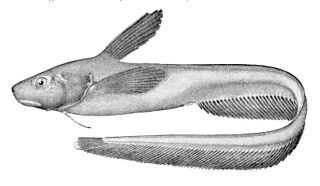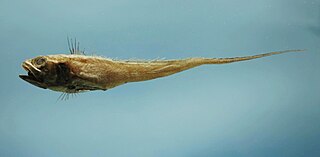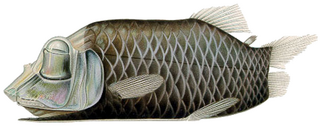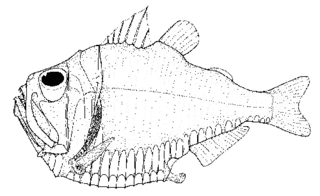Description and ecology
Found in tropical, subtropical and temperate waters of the Atlantic, Pacific and Indian Oceans, marine hatchetfishes range in size from Polyipnus danae at 2.8 cm (1.1 in) to the c.12 cm (4.7 in)-long giant hatchetfish (Argyropelecus gigas). They are small deep-sea fishes which have evolved a peculiar body shape and like their relatives have bioluminescent photophores. The latter allow them to use counter-illumination to escape predators that lurk in the depths: by matching the light intensity with the light penetrating the water from above, the fish does not appear darker if seen from below. They typically occur at a few hundred meters below the surface, but their entire depth range spans from 50 to 1,500 meters deep. [1] [5]
The body is deep and laterally extremely compressed, somewhat resembling a hatchet (with the thorax being the "blade" and the caudal peduncle being the "handle"). The genus Polyipnus is rounded, the other two – in particular Sternoptyx – decidedly angular if seen from the side. Their pelvis is rotated to a vertical position. The mouth is located at the tip of the snout and directed almost straight downwards. [1]
Their scales are silvery, delicate and easily abraded. In some species, such as the highlight hatchetfish ( Sternoptyx pseudobscura ), large sections of the body at the base of the anal fin and/or caudal fin are transparent. They have perpendicular spines and blade-like pterygiophores in front of the dorsal fin. The anal fin has 11–19 rays and in some species is divided in two parts; almost all have an adipose fin. Their large, sometimes tube-shaped eyes can collect the faintest of light and focus well on objects both close and far. They are directed somewhat upwards, most conspicuously in the genus Argyropelecus . This allows them to discern the silhouettes of prey moving overhead against the slightly brighter upper waters. [1] [5]
Lampriformes is an order of ray-finned fish. Members are collectively called lamprids or lampriforms, and unite such open-ocean and partially deep-sea Teleostei as the crestfishes, oarfish, opahs, and ribbonfishes. A synonym for this order is Allotriognathi, while an often-seen, but apparently incorrect, spelling variant is Lampridiformes. They contain seven extant families which are generally small but highly distinct, and a mere 12 lampriform genera with some 20 species altogether are recognized. They are the only extant members of the superorder Lamprimorpha, which was formerly diverse throughout much of the Late Cretaceous.

The jellynose fishes or tadpole fishes are the small order Ateleopodiformes. This group of ray-finned fish is monotypic, containing a single family Ateleopodidae. It has about a dozen species in four genera, but these enigmatic fishes are in need of taxonomic revision.

Stomiiformes is an order of deep-sea ray-finned fishes of very diverse morphology. It includes, for example, dragonfishes, lightfishes, loosejaws, marine hatchetfishes and viperfishes. The order contains 4 families with more than 50 genera and at least 410 species. As usual for deep-sea fishes, there are few common names for species of the order, but the Stomiiformes as a whole are often called dragonfishes and allies or simply stomiiforms.
Hatchetfish may refer to three groups of fishes:

Grenadiers or rattails are generally large, brown to black gadiform marine fish of the subfamily Macrourinae, the largest subfamily of the family Macrouridae. Found at great depths from the Arctic to Antarctic, members of this subfamily are amongst the most abundant of the deep-sea fish.

Macrouridae is a family of deep sea fish, a diverse and ecologically important group, which are part of the order of cod-like fish, the Gadiformes. The species in the Macrouridae are characterised by their large heads which normally have a single barbel on the chin, projecting snouts, and slender bodies that taper to whip-like tails, without an obvious caudal fin but what there is of the caudal fin is often confluent with the posterior dorsal and anal fins. There are normally two dorsal fins, the anterior dorsal fin is quite high, the posterior quite low but is longer and takes up a greater proportion of the fish's back. Species in the subfamily Macrouroidinae have a single dorsal fin. The long anal fin is almost as long as the posterior dorsal fin, and sometimes it is longer. The pelvic fin is inserted in the vicinity of the thorax and normally has 5–17 fin rays but these are absent in Macrouroides. The body is covered in small scales and if they have a photophore, it is usually on the midline of the abdomen just in front of the anus. The bioluminescence of these fish is produced by symbiotic bioluminescent bacteria. The structure of the skull has been used to show their placing in the Gadiformes, but they differ from the typical cods in that they possess one stout spine in the anterior dorsal fin.

The marine hatchetfishes or deep-sea hatchetfishes as well as the related bottlelights, pearlsides and constellationfishes are small deep-sea ray-finned fish of the stomiiform family Sternoptychidae. They are not closely related to and should not be confused with the freshwater hatchetfishes, which are teleosts in the characiform family Gasteropelecidae. The Sternoptychidae have 10 genera and about 70 species altogether.

Argyropelecus is an oceanic ray-finned fish genus in the deep sea hatchetfish family Sternoptychidae. A collective name is "silver hatchetfishes", but this can also refer to a species of the freshwater hatchetfishes which are not particularly closely related to this. The large pupils of these marine hatchetfishes enable them to see dim objects in the deep sea, where light barely penetrates.

Polyipnus is a genus of oceanic ray-finned fish in the family Sternoptychidae. This is the largest genus of the marine hatchetfishes subfamily Sternoptychinae and indeed of the entire Sternoptychidae. It is not quite as apomorphic as their relatives; it may be that the genus is actually a paraphyletic assemblage of less advanced Sternoptychinae and would need to be split.

Sternoptyx is an oceanic ray-finned fish genus which belongs in the family Sternoptychidae. This is the type genus of the Sternoptychidae, as well as the marine hatchetfish subfamily Sternoptychinae.

Barreleyes, also known as spook fish, are small deep-sea argentiniform fish comprising the family Opisthoproctidae found in tropical-to-temperate waters of the Atlantic, Pacific, and Indian Oceans.

Ridgeheads, also known as bigscales, are a family of small, deep-sea stephanoberyciform fish. The family contains approximately 37 species in five genera; their distribution is worldwide, but ridgeheads are absent from the Arctic Ocean and Mediterranean Sea. Although the family is one of the most widespread and plentiful of deep-sea families, none of its members are of interest to commercial fishery.

Argyropelecus hemigymnus, the half-naked hatchetfish, short silver hatchetfish or spurred hatchetfish, is a deep-sea hatchetfish of the genus Argyropelecus found mesopelagically in the Atlantic, Indian, and Pacific Oceans as well as in the Mediterranean Sea. It is a small species rarely exceeding 38 millimetres (1.5 in) standard length. It feeds on zooplankton, particularly ostracods and copepods. Sexual maturation occurs at length of about 22 mm, and adult males have more developed olfactory organs than females, i.e. the species is sexually dimorphic.

Argyropelecus gigas, the giant hatchetfish or greater silver hatchetfish, is a marine fish of the genus Argyropelecus. It is found in every ocean except the north Pacific in the mesopelagic zone of tropical and subtropical waters. "Giant" in relative terms only, this is the largest species of marine hatchetfishes, often exceeding 110 millimetres (4.3 in) standard length.
Berycomorus is an extinct genus of prehistoric marine ray-finned fish that lived during the late Eocene epoch. It contains a single species, B. firdoussi, from the Pabdeh Formation of Iran.

Argyropelecus aculeatus, the lovely hatchetfish or Atlantic silver hatchetfish, is a species of fish in the family Sternoptychidae. It may exceed 70 millimetres (2.8 in) standard length (SL). It lives in the mesopelagic zone of all oceans and performs diel vertical migration. A. aculeatus feeds on a large range of prey items; in the Gulf of Mexico ostracods and copepods dominated the diet of small individuals and euphausiids, molluscs, and fish the diet of larger ones. The silvery coloration and bioluminescence of the lovely hatchetfish allows it to hide from predators and prey in the down-welling light of the twilight zone.

Argyropelecus affinis is a species of ray-finned fish in the family Sternoptychidae, described by Garman in 1899, found in the tropical and subtropical Atlantic, Indian and Pacific Oceans. Common names for this fish include Pacific hatchetfish, deepsea hatchetfish and slender hatchetfish. It inhabits the upper mesopelagic zone between 350 and 600m during the day, and between 100m and 350m during the night and is either non-migratory or performs short daily vertical migrations. They are distributed widely throughout all tropical and temperate seas. They are known for its laterally compressed body and characteristic photophores, which aid in bioluminescence. Argyropelecus affinis is closely related to Argyropelecus gigas.

Argyropelecus sladeni, or Sladen's hatchetfish, is a species of ray-finned fish in the family Sternoptychidae, found in the tropical and subtropical Atlantic, Indian and Pacific Oceans. This small fish lives in the mesopelagic zone by day and makes a daily vertical migration to the epipelagic zone at night.

Sternoptyx diaphana, the diaphanous hatchetfish, is a species of deep sea ray-finned fish in the family Sternoptychidae. It is the type species of the genus Sternoptyx, and was first described by the French naturalist Johann Hermann in Der Naturforscher 1781.
Polyipnus clarus, commonly known as the stareye hatchetfish or slope hatchetfish, is a species of ray-finned fish in the family Sternoptychidae. It occurs in deep water in the western Atlantic Ocean from the Gulf of Maine southward to the Caribbean Sea and the Gulf of Mexico. It most commonly occurs between 300 and 400 metres but can range from 40 and 830 metres.














